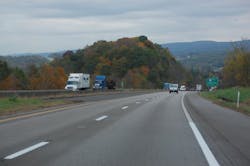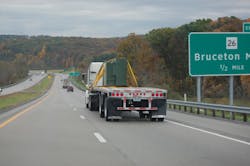According to the agency’s data, highway fatalities overall decreased 3.1% between 2012 and 2013 – falling to 32,719 – with injuries due to vehicular crashes down 2.1% to 2.31 million.
More importantly, NHTSA’s data indicates highway fatalities due to crashes are down 25% overall compared to 2004 – a general decline in fatalities that gained strength in 2006 and continued unabated except for 2012, when overall fatalities jumped by 3.3% or 1,082 more deaths.
But even that increase is somewhat misleading as NHTSA noted that 72% of those 1,082 additional fatalities not only occurred in the first quarter of that year – winter time, when roadway conditions can be more hazardous than usual – but also involved motorcyclists and pedestrians.
Yet it’s the longer-term trend that’s important here as the fatality rate notched for 2013 matched a historic low – 1.10 deaths per 100 million vehicle miles traveled in 2013, down from 1.14 deaths per 100 million vehicle miles traveled in 2012.
Here are some other statistics from NHTSA analysis that further highlights improving highway safety trends:
- The number of passenger vehicle occupants killed in crashes declined by 3% to 21,132 – the lowest number on record dating back to 1975. Large truck occupant and motorcyclist fatalities in 2013 declined for the first time since 2009, 0.9% and 6.4% respectively.
- Pedestrian fatalities declined by 1.7% to 4,735, though that remains 15% higher than the record low of 4,109 pedestrian deaths recorded in 2009.
- The number of people killed in distraction-affected crashes fell to 3,154 in 2013 from 3,380 in 2012; a 6.7% decrease. However, the estimated number of people injured in distraction-affected crashes (424,000) increased by 1% compared to 2012.
- The estimated number of people injured in crashes decreased across all categories in 2013 when compared to 2012, with declines among passenger vehicle occupants (2.2%), large truck occupants (4%), motorcyclists (5.4%), pedestrians (13%), and bicyclists (2%).
On the not-so-good side of the safety ledger book, though, some problematic increases occurred.
Fatalities among bicyclists – whom NHTSA calls “pedalcyclists” in its reporting (how’d they craft THAT awkward descriptive?) – increased by 1.2% to their highest level since 2006.
Truckers are in the crosshairs of this statistic to a degree due to several high-profile bike-truck crashes this year that generated renewed calls for mandatory side guards on commercial vehicles operating in urban areas.NHTSA also noted a small 0.5% increase in the number of people killed in crashes involving large trucks in 2013 compared to 2012 – with a 13% jump in the number of non-occupants killed in large-truck crashes from 2012 to 2013, or 49 more people, offset by a 0.8% decline in other vehicle occupant deaths and the aforementioned 0.9% drop in truck occupant fatalities.
Altogether, 3,964 died in large-truck crashes in 2013, an uptick of 0.5% or 20 more people compared to 2012.
Still, NHTSA made this important caveat to its data analysis: “Note that the number of fatal crashes involving large trucks is relatively small compared to those involving other vehicles, so even small changes in the numbers of fatalities may result in large percent.”
Overall, then, the longer-trend numbers continue to head in the right direction – which means, on balance, we’ve got to be doing something right in terms of highway safety.


